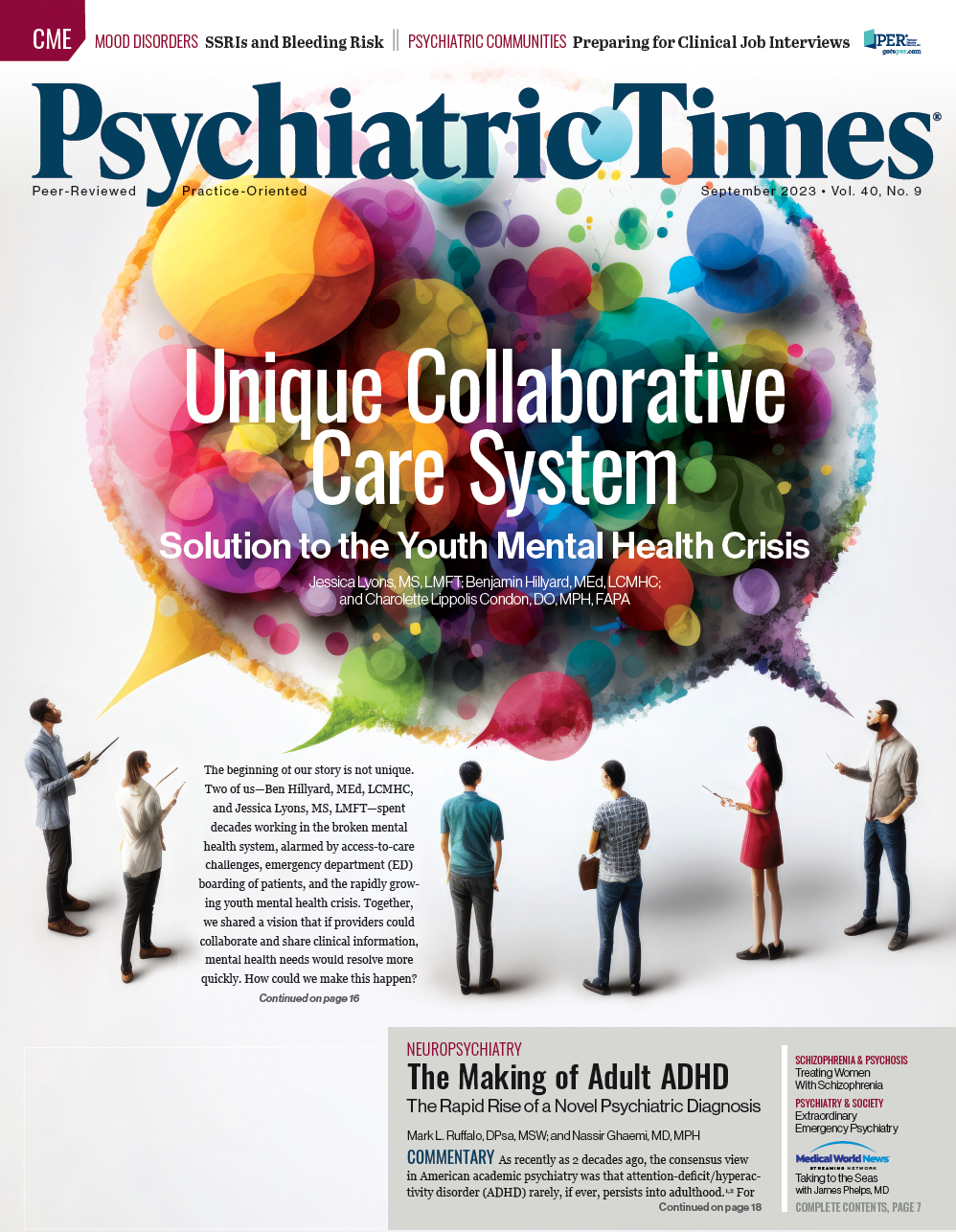News
Article
Psychiatric Times
Violence Risk Assessment in the Emergency Department
"As society continues to grapple with the consequences of violent behaviors, increasing efforts to understand and mitigate the risks of such behaviors using evidence-based methods and tools will be essential."
chrisdorney_AdobeStock

SPECIAL REPORT: EMERGENCY PSYCHIATRY
Although substantial progress has been made over the past several decades by mental health professionals to undertake suicide risk assessment with more structured approaches, violence risk assessment has lagged despite emerging evidence that highlights violence as a significant issue.
Violence has become an increasingly recognized problem in health care. Rates of violent behavior toward health care workers, especially frontline workers such as nursing staff, are high.1,2 Emergency departments (EDs) are notable for their high rates of violent incidents. A recent meta-analysis found that 77% of ED workers were subject to some form of workplace violence.3
The relationship between mental disorders and violence is complex. However, civil commitment laws connect danger and potential for violence to psychiatric assessment of need for involuntary hospitalization.4 Because of this, emergency mental health providers have been charged with violence risk assessment as part of their evaluation and treatment of patients with suspected behavioral pathology.
Although only a minority of patients with mental illness participate in severe violence, identification of individuals with mental illness who are at risk of significant violence has become as fundamental to psychiatric practice as assessment of risk for suicide.5,6 Currently, violence risk assessment by mental health professionals is largely based on clinical experience and unstructured consideration of known risk factors.7
Tools to Aid in the Assessment of Violence Risk
There are some robust tools available to aid clinicians in the assessment of violence risk. The Historical Clinical Risk Management-20, Volume 3 (HCR-20 V3), is a comprehensive, 20-item, structured clinical judgment approach to assessing violence risk that has been considered the gold standard in the evaluation of future potential risk for violence.8
Assessment of violence risk using this tool is thorough and comprehensive, but it has had no real utility in emergency psychiatric settings due to the length of time needed in its application, which can extend to several hours. The HCR-20 V3 also has days-long required training, and there has been difficulty integrating utilization of this instrument in an already overburdened emergency behavioral health care system.9
Other structured and semistructured tools to assess violence risk include the Violence Risk Screening-10,10 Classification of Violence Risk,11 Violence Risk Appraisal Guide-Revised,12 and the Psychopathy Checklist: Screening Version.13 These are not widely used in clinical practice outside of forensic settings for various reasons—including their proprietary nature, lack of clinician familiarity, and length of administration.
A brief instrument, the Brøset Violence Checklist, has gained more widespread use and has been utilized in inpatient settings in the prediction of imminent violence.14-16 Although this screening tool has not demonstrated ability to predict violence beyond the first few days of hospitalization, it may be useful in ED settings as a tool to anticipate and mitigate violent behavior.17
Risk Assessment in the Emergency Department
Recently, there has been some promising work demonstrating the effectiveness of a violence risk screening tool in the ED. A recent single-center study in Australia showed good predictive validity and interrater reliability of a novel 3-item tool that looked at aggression history, behavioral concerns, and clinical presentation to assess occupational violence risk toward ED staff.18
Findings from this study indicated that this unnamed tool is a promising step toward creating a tool that is useful, valid, and accurate in the ED setting. However, this work is preliminary, utilized a relatively small sample size, and has yet to be replicated.
The Fordham Risk Screening Tool (FRST) was developed as a brief instrument to help clinicians decide which patients need a more thorough violence risk assessment. The development of this screening instrument was based on the principle that information considered by the FRST should be readily available either before or during a standard psychiatric intake evaluation.
Thus, the aim was to create an easy-to-use screening tool to identify patients for whom more clinical resources should be targeted, including undergoing more comprehensive and time-consuming structured violence risk assessment.19
A recently published study compared the results of the FRST with the HCR-20 V3 for patients who presented to an emergency room in behavioral health crisis and were referred for emergency psychiatric evaluation.20
When compared with the gold-standard and more time-consuming HCR-20 V3, the FRST showed good sensitivity, specificity, and positive and negative predictive value in assessing violence risk for those patients who presented in mental health crisis. This work also showed it may be possible to introduce reliable and accurate violence risk screening in the fast-paced ED setting.
Future Directions, Pitfalls, and Ethical Concerns
As society continues to grapple with the consequences of violent behaviors, increasing efforts to understand and mitigate the risks of such behaviors using evidence-based methods and tools will be essential. Emerging efforts to develop effective and useful screening tools are promising, but there is still a gap in the literature regarding violence risk assessment strategies.
EDs are often the first point of contact for acute psychiatric care and therefore may be the ideal settings for violence risk screening as part of an emergency psychiatric evaluation. However, EDs and dedicated psychiatric emergency units are also grappling with innumerable systemic barriers including overcrowding, boarding, and staffing shortages.
Similar issues arise outside hospital-based settings, including at community crisis centers and psychiatric urgent care centers, which would also be natural settings for implementing such violence risk screenings. We therefore believe there is an urgent need for evidence-based screening strategies to evaluate and mitigate violence risk.
However, a screening tool such as the FRST is just one of the instruments that should be used in an overall comprehensive strategy to address violence risk in both hospitals and the community. To effectively minimize violence risk, development of coordinated strategies between different levels of care to communicate the potential for violence risk is essential. Efforts over the past decade in screening, assessment, and prevention of suicide may serve as a playbook for violence risk assessment efforts.
Ideally, a system in which violence risk screening is implemented would have follow-up resources and widely available effective treatment strategies. Unfortunately, this is not the current state of our fragmented and underresourced mental health system. Community and health system investment in greater availability of mental health resources will be necessary for any violence risk screening program to be effective.
Violence risk screening programs must also consider the potentially stigmatizing nature of these efforts. Popular media coverage of violent incidents often leads the public to overestimate the connection between violence and mental illness.5
Due to the risk of further stigmatization, any violence risk screening should demonstrate predictive ability for future violent behavior. Efforts should also proactively seek thoughtful consideration of how race, gender identity, socioeconomic background, and other demographic factors might affect violence risk screening tools and seek to avoid unintended bias. Balancing risk mitigation with stigma minimization will be an ongoing challenge to implement prospective violence risk screening and assessment.
Dr Racine is director of emergency psychiatry at the Maine Medical Center in Portland. Dr Johnston is chief resident of emergency psychiatry at Maine Medical Center.
References
1. Rosenthal LJ, Byerly A, Taylor AD, Martinovich Z. Impact and prevalence of physical and verbal violence toward healthcare workers. Psychosomatics. 2018;59(6):584-590.
2. Speroni KG, Fitch T, Dawson E, et al. Incidence and cost of nurse workplace violence perpetrated by hospital patients or patient visitors. J Emerg Nurs. 2014;40(3):218-228.
3. Aljohani B, Burkholder J, Tran QK, et al. Workplace violence in the emergency department: a systematic review and meta-analysis. Public Health. 2021;196:186-197.
4. McNiel DE, Binder RL. Violence, civil commitment, and hospitalization. J Nerv Ment Dis. 1986;174(2):107-111.
5. Ahonen L, Loeber R, Brent DA. The association between serious mental health problems and violence: some common assumptions and misconceptions. Trauma Violence Abuse. 2019;20(5):613-625.
6. Appelbaum PS. Violence and mental disorders: data and public policy. Am J Psychiatry. 2006;163(8):1319-1321.
7. Heilbrun K, Wolbransky M, Shah S, Kelly R. Risk communication of terrorist acts, natural disasters, and criminal violence: comparing the processes of understanding and responding. Behav Sci Law. 2010;28(6):717-729.
8. Challinor A, Ogundalu A, McIntyre JC, et al. The empirical evidence base for the use of the HCR-20: a narrative review of study designs and transferability of results to clinical practice. Int J Law Psychiatry. 2021;78:101729.
9. Viljoen JL, McLachlan K, Vincent GM. Assessing violence risk and psychopathy in juvenile and adult offenders: a survey of clinical practices. Assessment. 2010;17(3):377-395.
10. Roaldset JO, Hartvig P, Bjørkly S. V-RISK-10: validation of a screen for risk of violence after discharge from acute psychiatry. Eur Psychiatry. 2011;26(2):85-91.
11. Monahan J, Steadman HJ, Appelbaum PS, et al. The classification of violence risk. Behav Sci Law. 2006;24(6):721-730.
12. Glover AJJ, Churcher FP, Gray AL, et al. A cross-validation of the Violence Risk Appraisal Guide-Revised (VRAG-R) within a correctional sample. Law Hum Behav. 2017;41(6):507-518.
13. Skeem JL, Mulvey EP, Grisso T. Applicability of traditional and revised models of psychopathy to the Psychopathy Checklist: screening version. Psychol Assess. 2003;15(1):41-55.
14. Abderhalden C, Needham I, Dassen T, et al. Predicting inpatient violence using an extended version of the Broset-Violence-Checklist: instrument development and clinical application. BMC Psychiatry. 2006;6:17.
15. Almvik R, Woods P. Predicting inpatient violence using the Broset Violence Checklist (BVC). Int J Psychiatr Nurs Res. 1999;4(3):498-505.
16. Partridge B, Affleck J. Predicting aggressive patient behaviour in a hospital emergency department: an empirical study of security officers using the Brøset Violence Checklist. Australas Emerg Care. 2018;21(1):31-35.
17. Ramesh T, Igoumenou A, Vazquez Montez M, Fazel S. Use of risk assessment instruments to predict violence in forensic psychiatric hospitals: a systematic review and meta-analysis. Eur Psychiatry. 2018;52:47-53.
18. Cabilan CJ, McRae J, Learmont B, et al. Validity and reliability of the novel three-item occupational violence patient risk assessment tool. J Adv Nurs. 2022;78(4):1176-1185.
19. Rosenfeld B, Foellmi M, Khadivi A, et al. Determining when to conduct a violence risk assessment: development and initial validation of the Fordham Risk Screening Tool (FRST). Law Hum Behav. 2017;41(4):325-332.
20. Racine CW, Johnston DN, Quigley KM, et al. Utilization of the Fordham Risk Screening Tool for violence risk assessment in an emergency department. Acad Emerg Med. 2023;10.1111/acem.14735.






